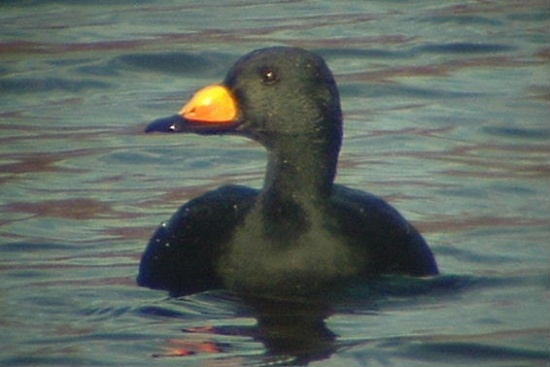| Line 1: | Line 1: | ||
| − | [[Image: | + | [[Image:American.JPG|thumb|550px|right|Male American Scoter<br />Photo by {{user|Luc|Luc}}<br />Barrage Sartigan-Québec, [[Canada]], November 2005]] |
| − | '''Alternative name: | + | '''Alternative name: American Scoter''' |
| − | ;[[:Category:Melanitta|Melanitta]] | + | ;[[:Category:Melanitta|Melanitta]] americana |
| − | |||
==Identification== | ==Identification== | ||
45-49cm<br /> | 45-49cm<br /> | ||
'''Male''': All black; very bulbous, mostly yellow bill.<br /> | '''Male''': All black; very bulbous, mostly yellow bill.<br /> | ||
'''Female''': Brown with pale cheeks and may have some yellow around the nostils. | '''Female''': Brown with pale cheeks and may have some yellow around the nostils. | ||
| − | |||
====Similar Species==== | ====Similar Species==== | ||
Females can be confused with female [[Red-crested Pochard]] which has a white wing bar and [[Long-tailed Duck]] which has a smaller bill and much whiter underparts. | Females can be confused with female [[Red-crested Pochard]] which has a white wing bar and [[Long-tailed Duck]] which has a smaller bill and much whiter underparts. | ||
| Line 13: | Line 11: | ||
Far north of [[North America]] in [[Labrador]] and [[Newfoundland]] to the southeast Hudson Bay, in [[Alaska]]. It winters further south on the coasts of the northern USA and [[Canada]], and in [[Asia]] as far south as [[China]]. | Far north of [[North America]] in [[Labrador]] and [[Newfoundland]] to the southeast Hudson Bay, in [[Alaska]]. It winters further south on the coasts of the northern USA and [[Canada]], and in [[Asia]] as far south as [[China]]. | ||
| − | |||
==Taxonomy== | ==Taxonomy== | ||
| − | [[ | + | This is a [[Dictionary_M-S#M|monotypic]] species.<br /> |
| − | + | It was formerly thought to be conspecific with [[Common Scoter]]. | |
| − | |||
| − | |||
| − | |||
| − | |||
| − | |||
==Habitat== | ==Habitat== | ||
Winters on sea-coasts, usually at some distance from the shore. <br /> | Winters on sea-coasts, usually at some distance from the shore. <br /> | ||
| Line 31: | Line 23: | ||
*Spring migration takes place overland at night. | *Spring migration takes place overland at night. | ||
*Autumn migration is along the coast during the day. | *Autumn migration is along the coast during the day. | ||
| − | |||
====Flight==== | ====Flight==== | ||
*Flies low to the water in long lines. Flight is strong and rapid.<br /> | *Flies low to the water in long lines. Flight is strong and rapid.<br /> | ||
| Line 39: | Line 30: | ||
====Breeding==== | ====Breeding==== | ||
The nest is built on the ground. The clutch consists of 5-7 eggs and are incubated for 27 to 31 days. | The nest is built on the ground. The clutch consists of 5-7 eggs and are incubated for 27 to 31 days. | ||
| − | |||
| − | |||
| − | |||
==References== | ==References== | ||
#{{Ref-Clements6thDec08}}#Avibase | #{{Ref-Clements6thDec08}}#Avibase | ||
| Line 51: | Line 39: | ||
{{ref}} | {{ref}} | ||
==External Links== | ==External Links== | ||
| − | {{GSearch|Melanitta+ | + | {{GSearch|Melanitta+americana}} |
[[Category:Birds]] [[Category:Melanitta]] [[Category:Bird Songs]] | [[Category:Birds]] [[Category:Melanitta]] [[Category:Bird Songs]] | ||
Revision as of 16:43, 5 January 2011
Alternative name: American Scoter
- Melanitta americana
Identification
45-49cm
Male: All black; very bulbous, mostly yellow bill.
Female: Brown with pale cheeks and may have some yellow around the nostils.
Similar Species
Females can be confused with female Red-crested Pochard which has a white wing bar and Long-tailed Duck which has a smaller bill and much whiter underparts.
Distribution
Far north of North America in Labrador and Newfoundland to the southeast Hudson Bay, in Alaska. It winters further south on the coasts of the northern USA and Canada, and in Asia as far south as China.
Taxonomy
This is a monotypic species.
It was formerly thought to be conspecific with Common Scoter.
Habitat
Winters on sea-coasts, usually at some distance from the shore.
Breeds on inland lakes or rivers, in woodland or tundra.
Behaviour
- Gregarious, may form very large flocks, especially with Velvet Scoter.
- Pointed tail is often raised.
- Spring migration takes place overland at night.
- Autumn migration is along the coast during the day.
Flight
- Flies low to the water in long lines. Flight is strong and rapid.
- Dives with a small leap.
Diet
The diet includes crustaceans and molluscs, insects and their larvae, fish eggs and vegetation such as duck weed while nesting on freshwater.
Breeding
The nest is built on the ground. The clutch consists of 5-7 eggs and are incubated for 27 to 31 days.
References
- Clements, JF. 2008. The Clements Checklist of Birds of the World. 6th ed., with updates to December 2008. Ithaca: Cornell Univ. Press. ISBN 978-0801445019.
- Avibase
- Birdwatchers Pocket Guide ISBN 1-85732-804-3
- Collins Pocket Guide to British Birds 1966
- Collins Field Guide 5th Edition
- Collins Bird Guide ISBN 0 00 219728 6
- 51st supplement to the AOU checklist of North American birds
Recommended Citation
- BirdForum Opus contributors. (2024) Black Scoter. In: BirdForum, the forum for wild birds and birding. Retrieved 12 May 2024 from https://www.birdforum.net/opus/Black_Scoter




